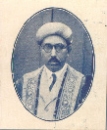It is clearly seen in the photo of the Imam when he was ordaining the New Ismaili Constitution that there was a small Ismaili flag on Imam's table, having an image of the Coat-of-Arms, i.e., the monogram of a crown (taj) on it. This is a royal monogram which was originally presented by Imam Sultan Muhammad Shah after his gracious arrival in India from Europe on March 2, 1920. Lt. Col. Pir Muhammad Madhani and Major A.J. Lakhpati had acknowledged its receipt on behalf of the volunteers Corps of Bombay at Imam's bungalow in Bombay on Saturday, April 3, 1920. The Imam said to them during presentation that, "Get such Coat-of-Arms prepared and every volunteer should wear it on his cap."
H.H. the Aga Khan IV ordained the new Ismaili Constitution on Saturday, December 13, 1986 at Merimont in Geneva. Leaders of the jamat who were mandated to work on the new Ismaili Constitution had come from various parts of the world. It was indeed a historic occasion where the family members of the Imam, members of the Constitution Review Committee and the staff of the Secretariat from Aiglemont were present. At 11.00 a.m., the Imam ordained, signed and sealed "The Constitution of the Shia Imami Ismaili Muslims"
The second unfurling ceremony of the Ismaili flag was performed in Andheri Jamatkhana, Bombay on Sunday, June 26, 1927 at 3.30 p.m. by the hands of Alijah Ismail Virji Madhani, the President of the Supreme Council for Kathiawar.
Mukhi Laljibhai Devraj (1842-1930) had an honour to perform the My Flag unfurling ceremony at Bandra Jamatkhana, Bombay on July 4, 1927.
Hasan bin Sabbah (1034-1124) took possession of the fort of Alamut in Iran in 1090. His immediate concerns were to refortify Alamut, provide for it food and water supply, irrigate the field in the valley, acquire adjacent castles, erect forts at strategic points, institute economic and social reforms and unite the Ismailis by bonds of fraternity. Thus, he succeeded to establish the Nizarid Ismailis rule in Alamut. It appears from the fragments of the historical sources that, the Ismailis continued green colour as their standard, and Hasan bin Sabbah is reported to have hoisted it for the first time on the summit of the Alamut.
Huzur Wazir Ali Muhammad R. Macklai (1843-1971), the then Major of the Bombay Volunteer Corps and the President of the Recreation Club Institute
Imam Sultan Muhammad Shah ascended on the throne of Imamate at the age of 7 years, 9 months and 16 days on August 17, 1885. His enthronement ceremony was solemnised at Bombay Dharkhana Jamatkhana on Friday, September 1, 1885. On that historic occasion, he sat on the oblong wooden throne surrounded by the elder persons of the community. The most striking feature was that the oblong cushion inside the throne was absolutely green, and the Imam sat in the centre in red attire. It explicitly depicted an image of the present design of the Ismaili flag.
The name "My Flag" had been applied by the Imam himself in his message to the Khadak Jamatkhana, Bombay on June 27, 1927.
It must be known that both ruby (yakut) and pearl (marjan) are the Koranic terms, having natural colours of red and green respectively. Ruby is a transplant red gemstone variety of the mineral corundum. Rubbies vary in colour from pale to deep red, also called the pigeon blood. On the other hand, the pearl is a substance forming the inner layers of the shells of nacreous mollusks, as pearl-oyster, abalones, etc., having rich green colour.
On Sunday, the 18th Zilhaja, 1345/June 19, 1927 during the historic occasion of Eid-i Ghadir, the unfurling ceremony of the Ismaili flag had been performed for the first time on the Indian soil in the compound of the Thana Jamatkhana.
One rare banner preserved in the Topkapi Saray Museum at Istanbul, called as-Sinjaqu 'sh-Sharif, is said to be a most sacred emblem. It is the original standard of the Prophet. It is made of four layers of silk, the top-most of which is green, those below being composed of cloth, embroidered with gold. Its entire length is twelve feet.
 Ismaili.NET - Heritage F.I.E.L.D.
Ismaili.NET - Heritage F.I.E.L.D.














